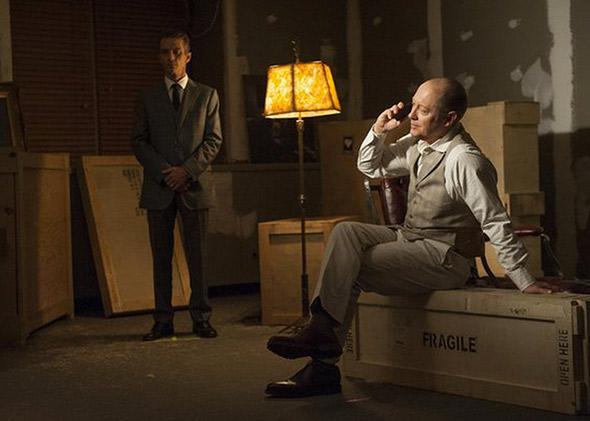The Blacklist, NBC’s series about a brilliant criminal mastermind who for mysterious reasons begins to help the FBI apprehend serious evildoers, is one of the big hits of the fall season. Starring James Spader in de facto scene-stealing mode, the show, which airs Monday nights, has more than 10 million viewers a week in the all-important demo and has already been given a full season order by NBC. Its premise is simple, but savvy to the point of elegance: As Grantland’s Andy Greenwald succinctly put it, “it’s a cop procedural with a criminal as the lead investigator,” the powerhouse marriage of a reliable genre and the trendiest of archetypes, the antihero.
As this high-concept premise suggests, The Blacklist is both utterly shameless and, in its way, genuinely (if cynically) sophisticated. Its protagonist, Raymond “Red” Reddington, will manipulate, kill, flatter, scare, flirt, joke to get what he wants, namely the trust and affection of a young FBI agent. The Blacklist will manipulate, kill, flatter, scare, flirt, joke to get what it wants, our attention and affection. The Blacklist has coolly learned one of the lessons of The Sopranos and Breaking Bad—that despite their creators’ best intentions, scads of viewers thrilled to the violence and troubled murderers they contained, even if they were not “meant” to—and has decided to offer them up, guilt free. The Blacklist, like its protagonist, is not concerned with ethics, just opportunity.
Spader stars as Reddington, who, in the first episode, promises to help the FBI nail a huge list of very bad guys, but only if he can work with a brand new agent named Elizabeth Keen (Megan Boon). His Reddington is a man of refined tastes, the amoral aesthete who appreciates poetry, a good tumbler of scotch, and beautiful women. Like most of Spader’s recent characters he is a strange, alluring mixture of clipped line readings, smarm, freaky sexual bravado, and deranged self-possession. Unlike most male actors who have an outsized on-screen presence, Spader vamps, crossing the line into camp like it’s the threshold to his front door. (What I would not do to see him and Jessica Lange in American Horror Story mode in a room!) It’s a kicky, kinky, and mannered performance grounded by an implacable, if inexplicable, self-confidence.
The early episodes heavily intimated that Keen is Reddington’s biological daughter. Every conversation the pair have had about why he insists on working with her has been carefully constructed so that it will signify differently in retrospect if and when we find out he is her father. On a sting, he tells Lizzie she can pretend to be his daughter; later, he explains he is interested in her primarily because of her father. Creator Jon Bokenkamp has learned from Lost: Don’t tease mysteries you can’t answer.
Bokenkamp cribs widely, in fact. Red owes so much to Hannibal Lecter, I presume his favorite meal is a meat course served with fava beans and chianti, he just hasn’t mentioned it yet. Keen’s house is being surveilled by a number of thuggish men, a setup straight out of Homeland. In one episode, Keen and Red hunt an assassin, nicknamed “The Stewmaker,” who dissolves his victims in the bathtub using chemicals and a gas mask, like he has learned how to get rid of corpses from Jesse and Walt.(Skinny Pete also appears on the show, implausibly, as Red’s polished attaché.) Last week, in a story straight from the original Scandinavian version of The Bridge, a guy got buried alive. And this is to say nothing of all the procedural plots The Blacklist happily lifts from. If these nods to other TV shows are lazy, that’s part of The Blacklist’s bravado, its brazen willingness to cadge from the best, no untended wallet safe in its presence.
The Blacklist is aware of the morally complex protagonists who have come before it in the golden age of the antihero, but it is not burdened by grandiose ambitions: It’s pure pop. Unlike Boardwalk Empire, Ray Donovan, Magic City, Hell on Wheels, and other shows made in The Sopranos’ image with long faces and nothing new to say about their tortured semi-good, semi-bad guys, The Blacklist delivers its no news with a fresh, fun attitude.
I can’t say that I find this ethically acceptable. (Emily Nussbaum, in her review for The New Yorker, called the show “odious torture porn,” and she’s not wrong.) But I also can’t deny that I find it a more entertaining than any of the aforementioned Fauxpranos. The Blacklist makes you like the bad guy without feeling bad about it. It’s a slick piece of work. It’s the kind of show that has Red getting decked out in sunglasses while “Sympathy for the Devil” plays (Bokenkamp knows his Scorsese too), the cool customer who, the show jokingly points out, has now unexpectedly murdered three people in just six missions. Reddington, with nearly the panache of Some Like It Hot’s Osgood, shrugs the homicides off with an “I’m not perfect.” In another bit, Red tells a CIA agent, “You look like the CIA.” “What does the CIA look like?” she asks. “Attractive but treacherous,” Red answers—and a couple of scenes later she effectively extracts information from a source by sticking her fingers into his bloody compound fracture. A recent episode was devoted to trapping a killer who couldn’t feel pain and hid objects in his own self-inflicted wounds, a perfect villain for The Blacklist, a show in which nothing is supposed to hurt.
